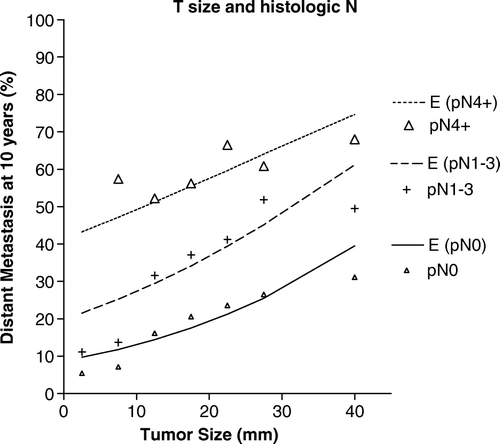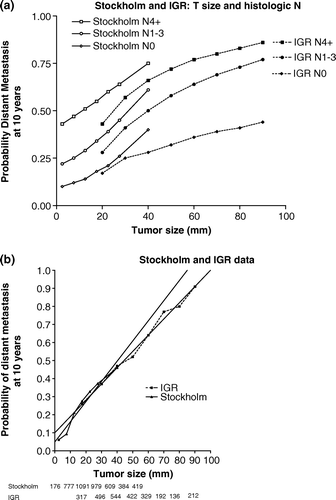Figures & data
Table I. Patient characteristics and results of the univariate and multivariate analyses for 3 080 patients with known values of histologic tumor size, lymph node status and receptor status. Endpoint is distant metastasis.
Figure 1a. Probability of distant metastasis at 10 years according to two metastasis risk scores (MRS) as a continuous variable, including (MRS1) and excluding progesterone receptors (MRS2). The other two factors considered were the histologic tumor size and the number of involved axillary lymph nodes. Figure 1b. Probability of distant metastasis at 10 years according to three groups of risk defined by two independent factors: histologic tumor size and number of involved lymph nodes. The metastasis risk groups were defined according to a score below 0.5 (low risk), between 0.5 and 1.5 (intermediate risk) and above 1.5 (high risk).

Table II. Results of the univariate and multivariate analyses for 4 435 patients with known values of histologic tumor size, and lymph node status. Endpoint is distant metastasis.
Table III. Ten-year cumulative incidence rates (first cause of failure and total events ) according to risk of distant dissemination in 4 435 patients with known values of histologic tumor size and lymph node status.
Figure 2. Probability of distant metastasis at 10 years according to the histologic tumor size and the number of involved axillary lymph nodes. Lines represent the estimations obtained by a Cox model for the effect on each category and marks are the observed values for pN0 (o), pN1-3 (+) and pN4+ (Δ).

Figure 3a. Probability of distant metastasis for the Stockholm database – unfilled marks-compared with the IGR published data (12) – black marks – according to tumor size and lymph node involvement. Figure 3b. Overall results of 10-year distant metastasis rate for the Stockholm material –triangles – according to histological observed values of tumor size and for the IGR published data (12) – squares according to clinical tumor size. The linear fitting for the Stockholm series is r2=0.96, and for the IGR series r2=0.99; both highly significant (p < 0.0001). The numbers of patients in each group are given at the bottom.
